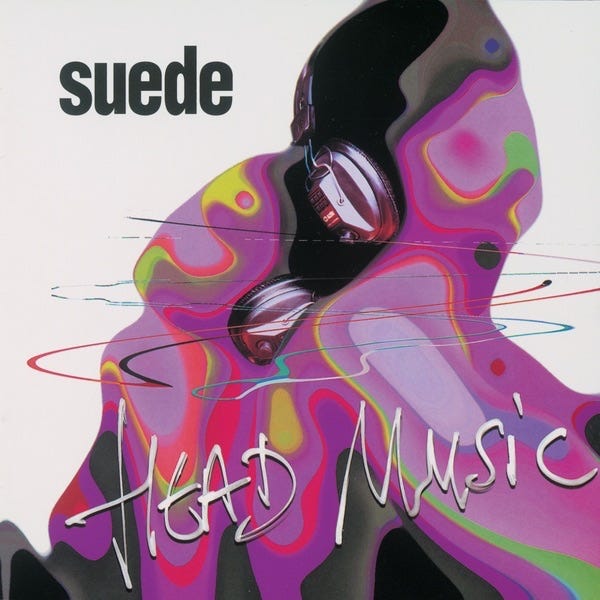Head Music was never going to be an easy album for me to write about. At some point in the 26 years since Suede released it, I convinced myself that, except for “Electricity,” I pretty much universally hated Head Music and had no desire to listen to any of its tracks, let alone sit through multiple playthroughs from top to bottom. Once I started re-listening and jotting down my preliminary thoughts for this post, I began to realize that it wasn’t anything about Head Music specifically that was alienating and putting me off, but rather its association with where I was physically and mentally in 1999, the year it was released.
1999 is as close as I get to having an annus horribilis. I was in the midst of a sexuality identity crisis, stuck at a job I hated that was causing me to kill myself with caffeine, nicotine, and mindless episodes of fog eating, helplessly watching my father succumb to cancer, and unaware that I was drowning in my own clinical depression. Honestly, through the first half of 1999, music was the only thing keeping me tethered to sanity. I would get home to my empty apartment in Waterloo, Ontario after a gut-churning day at that soul-sucking job, order in some grease-soaked fast food, smoke cigarettes and listen to records while thumbing through my collection of UK music magazines (in my mind’s eye, it’s always The Boy With the Arab Strap on the stereo and a copy of Q magazine in my hands). By the time the millennium clocks clicked over to 2000, I had quit my job and gone back to school to earn my teaching degree, dropped 30 pounds and was exercising regularly, moved home with my mom and was mourning and missing my father after his death in August. Not exactly good times.
By all accounts, making Head Music wasn’t exactly good times for Suede, either. After the success of Coming Up and the coalescing of the band’s new five-piece line-up, Suede took some much-needed time off to regroup and refocus before working on a fourth album. By this point in their career (late 1997, after releasing the Sci-Fi Lullabies B-sides compilation), though, Suede were a band with nowhere to go. Their previous records all had stakes to them. The 1993 self-title debut needed to meet (if not exceed) the expectations of all the hype that had come up around them; sophomore album Dog Man Star had to blow away every preconceived notion people had of Suede after their first record; Coming Up needed to humble and silence the skeptics who couldn’t conceive of a Bernard Butler-less Suede.
As much by choice as by design, every subsequent Suede album was a polar opposite response to the last, so the only real pressure on album four was to keep the pendulum swinging in the opposite direction of Coming Up, and the band themselves mostly imposed that. Despite their personal struggles, Suede remained committed to their music. But Suede were in no condition to fully commit themselves to making their fourth masterpiece in a row. At the time, Brett Anderson was entirely in the grips of an all-consuming drug addiction and dead-set on Suede becoming the music lovechild of Prince and the Happy Mondays, Neil Codling was struggling with a mysterious illness that would later be diagnosed as chronic fatigue syndrome, Richard Oakes was pouring liquid courage down his throat to even step foot into the studio where he felt his skills and talents weren’t wanted or needed, and neither Simon Gilbert nor Mat Osman seemed to have any sense of the direction Suede needed to go in. After parting ways with stalwart producer Ed Buller, producer-of-the-moment Steve Osborne (whose credits included Happy Mondays’ Pills 'n' Thrills and Bellyaches, Lush’s Lovelife, and Placebo’s Without You I'm Nothing) was brought in to give Suede an EDM makeover and help bring out the funk that Anderson so desperately wanted to hear.
It all sounds like a recipe for disaster. And for many years, that’s how I thought of Head Music: a perplexing chapter in the Suede discography, marked by strained and troubled band relationships, drug addiction, and a rudderless sense of needing to reinvent themselves because that’s what’s expected of them. Yet, though Head Music in 2025 does sound like a band caught in an out-of-control spiral, it is a shockingly solid—dare I say impressive?—account of a band in utter free fall that (mostly) manages to stick the landing.
Neither lyrically profound nor musically groundbreaking, “Electricity” is a track I can’t help but love despite its simplicity. It’s a bona fide Anderson/Codling/Oakes classic that makes a solid case for having three songwriters in Suede. Its relentless drive and pulsing electronic squelches genuinely raised my hopes for what Head Music might sound like when I first heard “Electricity” as an advance single. Like “Trash” on Coming Up, “Electricity” serves as a tone setter for the album that follows, but any momentum gathered sputters and stalls on “Savoir Faire.” Anderson’s attempt to inject funk into Suede’s veins feels like a bad trip. The song’s lyrics are vapid and empty to the point that they diminish what could have been a groovy side-step. “Savoir Faire” (credited to Anderson alone) is quite frankly a clunker, and Head Music would be better off if it had been left off.
Three songs in, it’s pretty clear that Anderson’s lyrical well is running dry. As many have rightfully pointed out, “Can’t Get Enough” isn’t exactly inspired poetry. Still, it musically captures the Head Music spirit in a way that feels authentic, embodying a reckless, love-it-or-hate-it attitude that is one of the throughlines coursing through the album (an Anderson/Codling composition for those keeping track).
“Everything Will Flow” somewhat abruptly introduces Head Music’s other throughline, a more languid and fluid-sounding Suede that refines and recontextualizes elements of their musical past. An Anderson/Oakes composition, “Everything Will Flow” sounds like it could be from a wholly different album than the one the first three tracks were on. It’s far from my favourite Suede song, and not one I liked very much in 1999, but lately I’ve come to appreciate its elegance amid Head Music’s chaos. Similarly, “Down” was previously always a skip for me, but upon revisiting it now, it emerges as a highlight and standout. Anderson’s vocal performance is one of his best, set amid a boundary-pushing arrangement by Oakes that is unlike anything in the Suede canon up to that point. It’s raw, honest, and one of the most human moments on the record.
There is an alternate reality version of Head Music—with “Everything Will Flow” and “Down” as anchor tracks—that would have been a far more coherent and connected record, less overtly influenced by crack and heroin addiction. Whether this alternative is any good as a follow-up to Coming Up is debatable, but it’s one of those sliding doors moments where you can’t help but wonder what the consequences would have been for Suede if their instincts led them to take their electronic experimentation towards the more ambient and textured sounds on these two track instead of the abrasiveness on most of Head Music.
Either way, “She’s in Fashion” would (and should) have had a spot on the track list of whatever version they ended up releasing. Anderson and Codling’s summery pop standard remains a standout ear candy moment—a breezy and, yes, funky slice of joy that offsets the grit and grizzle surrounding it. “Asbestos” (Anderson/Codling again) also offers a welcome reprieve by way of its bluesy shuffle and horn embellishments. I don’t have strong feelings about the song, but I appreciate how Codling is introducing a different musical gear for Suede. While still not impressive on the lyrical front, “Asbestos” ends this solid four-song run on Head Music before the title track (penned by Anderson) takes a left turn and doubles back to the dirty synths and sinewy sequences it first started with.
“Head Music” is musically stronger than “Savoir Faire,” but the embarrassingly cringeworthy chorus (“Give me head / give me head / give me head music instead”) makes it the album’s second swing-and-a-big-miss moment. Codling’s “Elephant Man” is a T. Rex-inspired stomp that adds texture, dynamics, and swagger to the album’s latter half. It was considered as a possible single, but its brawn is better utilized as a gritty album cut.
While I don’t think it gets recognized as canonical Suede, “Hi-Fi” is, quite frankly, the linchpin holding any semblance of a theme or style together on Head Music. It’s the best Anderson solo composition on the album, and one of its boldest and best-executed stylistic leaps. Anderson’s second-last solo composition on the album, “Indian Strings,” is often cited as another creative milestone, but I have never found it to be anything special.
“He’s Gone,” on the other hand, is damn near perfect. Codling’s music is a haunting and nuanced setting for Anderson’s voice, which sounds confident and in the moment in its performance. Swinging back towards the sounds they were cultivating on “Everything Will Flow” and “Down,” it would have been the perfect note to end Head Music on instead of the utterly unnecessary “Crack in the Union Jack” (by far the worst Anderson solo composition on the album).
Revisiting Head Music has been unexpectedly cathartic. What once felt like a chaotic, alienating listen resonates with a strange kind of clarity. Maybe it’s because I can finally separate the music from the moment. Maybe it’s because I now understand that the chaos was the point. Suede was falling apart (for a moment), and so was I (temporarily). We both made it through. In a funny way, Head Music doesn’t just feel like an album I initially dismissed when it first came out; I now think of it as a time capsule of survival, of trying to find beauty in the breakdown. It’s not Suede’s best record, but it might be their most human—flawed, vulnerable, and still standing.
Head Music is a fascinating study in creative overreach and internal disarray. It captures Suede at a crossroads, as they attempt to reconcile their glam rock legacy with the electronic zeitgeist of the late 1990s. Yet even in its messiness, it remains a compelling artifact that I can’t help but think hints at a more coherent alternate version, one where “He’s Gone” closes the album with grace, “Down” and “Everything Will Flow” form the emotional core, and ambient textures replace abrasive indulgences. That version is a thing of speculative fiction at this point, easily assembled through personalized DSP playlists, sure, but will always be lacking some sense of authenticity. Head Music, for all its flaws and idiosyncrasies, still manages to stand on its own shaky legs. Perhaps that’s what makes it the most Suede album of all: beautiful, broken, and still worth listening to.
![the act of just being [t]here](https://substackcdn.com/image/fetch/$s_!moQy!,w_80,h_80,c_fill,f_auto,q_auto:good,fl_progressive:steep,g_auto/https%3A%2F%2Fsubstack-post-media.s3.amazonaws.com%2Fpublic%2Fimages%2Fedc03f78-2893-4045-9600-2bacb96b8fa5_1080x1080.png)
![the act of just being [t]here](https://substackcdn.com/image/fetch/$s_!pLeR!,e_trim:10:white/e_trim:10:transparent/h_72,c_limit,f_auto,q_auto:good,fl_progressive:steep/https%3A%2F%2Fsubstack-post-media.s3.amazonaws.com%2Fpublic%2Fimages%2F0d02a71c-d57a-4a4b-b90c-22191b1e1244_2688x512.png)

